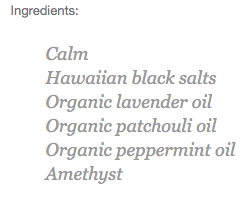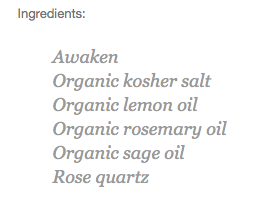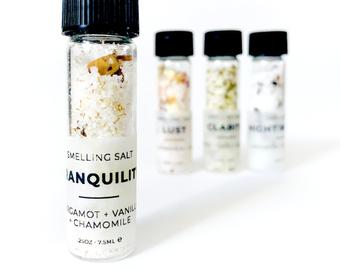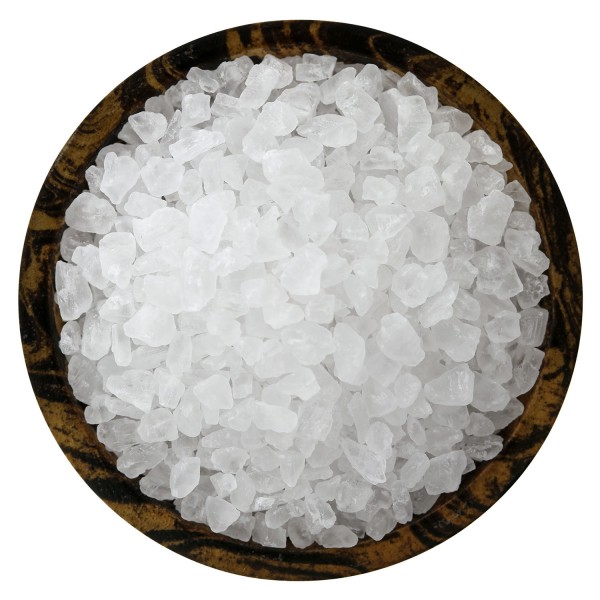A SALTY PAUSE
Inspiration
Concept
Process
Theory
By Dhyani Parekh , Wynona Bakker & Tamara Damberg
Places
SENSES & SMELLS
1. Sea breeze
This fragrance is linked to holiday time and relaxation. Because of this association it is great for soothing an overactive and worried mind.
2. Ylang ylang
Perfect for soothing an argument, ylang ylang is known for its relaxing properties. "The pure essential oil of these blossoms has been found to aid issues of palpitations, anxiety, depression, and high blood pressure,". Ylang Ylang aroma has been shown to be relaxing and decrease blood pressure in many small studies. One study found that Ylang Ylang aroma calmed the nervous system, leading to lower heart rate and blood pressure.
3. Lavender
This lovely fragrance can help reduce emotional stress and calm your nerves. The essential oil can also improve tension, depression and headaches. An example of a situation lavender is good for is the school run. Lavender can also help you drift off to sleep so place it in your bedroom too.
4. Lemon
Citrus scents work wonders at calming work stress. Lemon and other citrus fragrances improve concentration and have calming properties.
5. Grassy notes
A lot of people love the smell of freshly cut grass as it reminds them of happy, summer days. This is why scents with grassy notes can have a positive impact on your mental state. A hectic shopping trip can be helped with this specific smell.
6. Rosemary
A stressful supermarket shop can be eased by rosemary. It can improve your memory and reduce feelings of mental and physical tiredness due to its stimulating properties.
7. Yuzu
A new study from Japanese researchers has found that yuzu citrus scent can soothe stress and anxiety and lower your heart rate in just 10 minutes, with effects lasting for almost half an hour. Yuzu is a type of East Asian yellow citrus fruit often used in Asian cuisine.
The Japanese custom of yuzu-yu or yuzu baths in which whole yuzus float in hot baths to relieve stress dates as far back as the 18th century. You can try diffusing yuzu or other similar citrus fruit essential oil, which can be more affordable, including lemon. Some earlier studies have found that lemon can also be stimulating and increase heart rate, so the results are mixed, but you can try it out to see how it affects you.
8. Jasmine
Has a sweet aroma and can be relaxing fragrance. Jasmine essential oil is less well-studied, but does have one study that suggests that the odor of jasmine tea can be calming.
AROMA
RELATIONSHIP AROMA & BRAIN
Whether it’s the delicious smell of fresh baked banana bread or roasted vegetables, the natural aromas of lavender soap, flowers in the park, or pine trees or in a forest, aromatherapy is a powerful way to relax. You can create the type of atmosphere that you want with natural aromas from flowers or essential oils. Ninety-nine percent of taste is in fact smell, so take a moment to inhale a piping hot mug of your favorite tea and slowly and deeply breathe in the flavor of your food, appreciating where it came from and how it was made.
For millennia, ancient cultures like China, India and Egypt recognized that certain natural aromas are deeply soothing, and folk healers have long prescribed scented essential oils for treating stress-induced conditions like anxiety, insomnia and headaches. But science is still trying to figure out exactly how and why these potent aromas produce calming physiological responses.
Our sense of smell is triggered when fragrance molecules attach to special cilia-covered olfactory receptors in the nasal cavity. Those receptors then send electrical signals directly to the olfactory cortex of the brain, which in turn talks to the memory and emotion centers of the brain like the hippocampus, amygdala and frontal cortex.
A study out of Japan strengthens the theory that some smells can act like nature's own anti-anxiety medication, tweaking our brain chemistry in ways that mimic the effects of prescription drugs like Valium and diazepam. (The study was published on Oct. 23, 2018, in the journal Frontiers in Behavioral Neuroscience.)
In a series of experiments, Japanese researchers ran mice through mazes and other rodent stress tests while exposing them to an aroma called linalool, the organic compound that gives lavender its sweet floral scent. From previous studies, they suspected the linalool would lower anxiety levels in the mice, which it did. But the scientists also wanted to test a hypothesis that lavender's calming effect went straight from the mouse's nose to its neurons.
So they included mice in the study that were "asnomic," meaning they had no sense of smell. Those mice showed no effect of exposure to linalool, proving that the olfactory system was definitely the delivery mechanism. Next, they wanted to figure out if linalool was targeting the same receptors in the brain as some of the most common prescription anti-anxiety meds.
Drugs like Valium, Xanax, Klonopin and diazepam are all members of the same drug family called benzodiazepines. One of the causes of clinical anxiety is overactive neuronal activity in the brain. Benzodiazepines can inhibit or calm down neuronal activity by binding to particular sites on neurons called GABA receptors. When a drug like Valium binds to a GABA receptor, it increases the flow of certain chemicals into the neuron that mellow the brain out.
The Japanese researchers made a strong case that the smell of lavender acts on those very same GABA receptors. They did this by treating some mice with flumazenil, a drug that blocks GABA receptors. And when those treated mice sniffed the linalool, they didn't exhibit any calming effects.
As Powerful As Sleeping Pills
Lavender isn't the only aroma that's been linked to the same neuron receptors as potent anti-anxiety drugs. A few years ago, German researchers tested hundreds of fragrances on GABA receptors in rodents and humans and the big winner was jasmine, which delivered a GABA effect as powerful as sleeping pills and sedatives.
Lavender and jasmine are the first ancient relaxation remedies to be tested like this, but several others may share a similar nose-to-brain mechanism. According to the Japanese study, other compounds that have shown promising anti-anxiety effects in mice and men include limonene, the aroma of citrus peels, and pinene, the smell of pine trees.
AROMAS & MEMORIES
Aromas aren't universally relaxing, though. Since smells share such a close neurological connection to memories and emotions, their physiological effects can also be altered by our personal experiences. Like Pavlov's dog, our brains can be conditioned to love or hate certain smells depending on our associations with them. For example, if your mom made you scrub toilets as a kid with a lemon-scented cleaner, you might not find the odor all that soothing.
Research has shown that the olfactory system has the strongest direct line to the hippocampus and the amygdala, which are the memory and emotional centers of the brain. This is why scent memories can evoke such powerful feelings of nostalgia. A smell can carry us back to a specific time and place in ways that conscious thinking and remembering cannot.
That might explain why we find the smell of baby powder so soothing; it summons feelings of security and love from deep in our earliest memories. But even that smell appears to have cultural variations. Americans associate the "new baby smell" with vanilla and "powdery" scents, while French babies smell like orange blossoms.
(https://science.howstuffworks.com/what-makes-scent-soothing.htm)
> jasmine, lavender, limonene, the aroma of citrus peels, and pinene, the smell of pine trees.
SMELLING SALT
The usual active compound is ammonium carbonate—a colorless-to-white, crystalline solid. Because most modern solutions are mixed with water, they should properly be called "aromatic spirits of ammonia".[1] Modern solutions may also contain other products to perfume or act in conjunction with the ammonia, such as lavender oil or eucalyptus oil.[2]
Historically, smelling salts have been used on people feeling faint, or who have fainted. They are usually administered by others, but may be self-administered; some at-risk groups, such as pregnant women, may be advised to keep them close to hand.
Smelling salts are often used on athletes (particularly boxers) who have been dazed or knocked unconscious to restore consciousness and mental alertness. Smelling salts are now banned in most boxing competitions, but are not harmful.
They are also used as a form of stimulant in athletic competitions (such as powerlifting, strong man and ice hockey) to "wake up" competitors to perform better. In 2005, Michael Strahan estimated that 70–80% of National Football League players were using smelling salts as stimulants.
(https://en.wikipedia.org/wiki/Smelling_salts)
HISTORY
Smelling salts have been used since Roman times and are mentioned in the writings of Pliny as Hammoniacus sal.[1] Evidence exists of use in the 13th century by alchemists as sal ammoniac. In the 14th century's The Canterbury Tales, a character purports to use sal armonyak.[9] In the 17th century, the distillation of an ammonia solution from shavings of harts' (deer) horns and hooves led to the alternative name for smelling salts as spirit or salt of hartshorn.
They were widely used in Victorian Britain to revive fainting women, and in some areas constables would carry a container of them for the purpose.[10] During this time, smelling salts were commonly dissolved with perfume in vinegar or alcohol and soaked onto a sponge, which was then carried on the person in a decorative container called a vinaigrette.
The use of smelling salts was widely recommended during the Second World War, with all workplaces advised by the British Red Cross and St. John Ambulance to keep smelling salts in their first aid boxes.
HOW IT WORKS
Smelling salts release ammonia (NH3) gas, which triggers an inhalation reflex (that is, causes the muscles that control breathing to work faster) by irritating the mucous membranes of the nose and lungs. Fainting can be caused by excessive parasympathetic and vagal activity that slows the heart and decreases perfusion of the brain. The sympathetic irritant effect is exploited to counteract these vagal parasympathetic effects and thereby reverse the faint.
Smelling salts: a brief history.
Back in ancient Roman times and extending through the Victorian era, smelling salts were used to revive men and women who had fainted or were feeling ill. The main active ingredient was an ammonia derivative mixed with pulverized deer antlers and fragrance to create a dried-out, saltlike dust people called "sal ammoniac." The ammonia works by irritating mucosal linings of the mouth and nose, triggering an inhalation reflex and arousal via the nervous system—all helpful things for someone who just passed out.
Flash-forward to today, and there are two very different types of smelling salts on the market; one has been around for years and the other is brand-new. The older variety has earned a reputation as a stimulating mechanism for professional sports players, particularly the NFL and NHL. Athletes and powerlifters use smelling salts derived from the original Victorian formula with roughly 35 percent alcohol and 15 percent ammonium. These smelling salts are not banned from professional sports leagues (save boxing), and there are many articles that say these particular smelling salts are safe to use, but the truth is that there isn't much research to confirm it.
Smelling salts 2.0: the all-natural, aromatherapeutic variety.
The green, all-natural, modern version of smelling salts, on the other hand, is a trend we can get behind—simple ingredients like actual salt and essential oils are totally safe for sniffing (read: not snorting!). Leading the all-natural smelling salts trend is Josh Beeler, long-time brow guru at Brooklyn's natural beauty mecca, SHEN, with the launch of his line VOLAR that includes three different blends of smelling salts. The different scent combinations work to decrease anxiety, increase focus, and invoke calm.
"Smelling salts came out of necessity," said Beeler. "I don't wear fragrance, but sometimes you need a little something, like scent, to change your state of mind." In addition to being inherently antimicrobial and antifungal, salt is cleansing for both the mind and body. "It's a good way to escape. If you're feeling trapped, in an elevator for example, or if you get on the stinky subway car (as I always do), smelling salts can help make those situations better." Indeed, the olfactory nerve is the only cranial nerve that has direct contact with the environment, which is why scent has the power to conjure childhood memories, calm the system, or, like Beeler mentioned, give way to an escape.
His line VOLAR, which means to fly in Spanish, also includes mists and body oils in the same combinations: awaken, ascend, and calm. Other brands on the smelling salts bandwagon include Fig + Yarrow, Therapie, and Portland General Store, and I expect you'll see even more pop up more in the coming year.
(https://www.mindbodygreen.com/articles/volar-beauty-josh-beeler-smelling-salts)
THERAPIE'S daily wellness range helps you stay In-tune all day long. A modern take on an old fashion remedy. These bright energising crystals helps to inspire, lifting your energy and spirits when they’re flagging.
INSPIRATION
Smelling salts once foul smelling ammonia was it’s main ingredient - to create an impactful reviving inhalation.
CONTAINS
Crystal Clear Smelling Salts 100g, Crystal Clear Essence 5ml
TUNED IN
Physical - Awakens and revives.
Emotional - Vital, refreshed and optimistic.
Spiritual - Expanded perception and focus.
TUNED OUT
Physical - Tiredness and brain fog.
Emotional - Flat and lacking in inspiration.
Spiritual - revives the spirit.
KEY INGREDIENTS
Rosewood - Refreshes and promotes a sense of courage and a can do attitude.
Frankincense - A sacred oil of protection that wards off negative energy and promotes self expression.
Wild Rose - Heart opening this oil vibrates and one of the highest frequencies 320 MHZ helps to lift the vibration of mind and spirit.
RITUAL | Open jar and inhale deeply two or three times, if in need of further stimulus leave jar open whilst you work. Refresh salt with essence every two weeks.
INGREDIENTS | Litsea Cubeba (may chang) fruit oil, Citrus Clementina (clementine) Peel oil, Lacandula Angustifolia (lavender) flower oil, Aniba Rosaeodora (wood oil), Melaleuca Viridiflora (niaouli) leaf oil, Boswellia Carteri (frankincense) resin oil, Rosmarinus offcinalis (rosemart) leaf oil, Mentha Arvensis (wild mint) lead oil




other ingredients:
There are many aroma's that can help stimulate feelings of relaxation and calmness.
Combined with salt, certain essential oils can create a blend of relaxing smells.
The smell of essential oil-infused salts will last much longer.
RECIPE
INGREDIENTS
• 2 tbsp. coarse sea salt (i.e. Himalayan, dead sea, Celtic, etc.)
• 20 drops (approximately) of essential oil (divide up the oils you are using to make 20 drops total)
• Glass condiment mixing bowl (small)
• Wooden spoon
• Glass bottle with cork or glass dish (you can use the mixing bowl as well)
DIRECTIONS
• Measure 2 tbsp. of sea salt and pour into your glass mixing bowl.
• Add the essential oils of your choice to the salts. You may want to start with just a few drops of each oil and build on it to get the scent you want. You may also want to make a note of the total amounts you used of each so you can replicate it in future.
• Mix with the wooden spoon.
• Either transfer into a glass bottle with cork, or use in the condiment bowl.
COMBINATIONS OF SALT & OIL BLENDS
• ENERGY, WAKE UP
- Kosher salt, lemon, rosemary, sage, rose quartz.
- Peppermint (Mentha piperita) as the top note, rosemary (Rosmarinus officinalis) as the middle note and
Peru balsam (Myroxylon pereirae) as the bottom note.
- lemon, ginger, grapefruit, orange, lemongrass, basil, pine, rosemary.
• RELAXING, ANTI-STRESS
- Lavender (Lavender angustifolia) as the top note, ylang ylang (Cananga odorata var genuine)
as the middle note and vetiver (Vetiveria zizanioides) as the base note.
- hawaiian black salt, lavender, patchouli, peppermint, amethyst
- lavender, ylang ylang, neroli, roman chamomile, bergamot, vetiver, rose.
• UPLIFTING, REFRESHING
- himalayan pink salt, spruce, lemongrass, patchouli , lavender, quarts
- rose, sandalwood, orange, lavender, ylang ylang, frankincense, jasmine.
• ANXIETY
9 drops chamomile essential oil
6 drops sandalwood essential oil
3 drops balsam essential oil
- Lavender, Eucalyptus
- Chamomile & Sandalwood
• FEAR RELIEF
10 drops rose essential oil
6 drops Melissa essential oil
4 drops neroli essential oil
• PANIC RELIEF
13 drops lavender essential oil
5 drops bergamot essential oil
2 drops valerian essential oil
• FOCUS / STUDING
- Peppermint
- Rosemary & Basil
- Cyprus
• COLDS / CONGESTION
- eucalyptus, peppermint, camphor, thyme, rosemary.
- Pine & Eucalyptus
- Juniper berry & pine or thyme
- Tea tree & Rosemary
- Pretty much anything with natural camphor
(https://www.vogue.com/article/smelling-salts-aromatherapy-recipes-anxiety-stress-fear)
(https://aminoapps.com/c/thewitchescircle/page/blog/make-your-own-smelling-salts/5r34_jdSVuL3E0Kk75G5pL4Zn4d4J7jnkE)
(https://www.wikihow.com/Make-Smelling-Salts)



Flask with smelling salts, used for reviving dental patients after a procedure. French, 18th century.
In Rembrandt's Unconscious Patient (Allegory of Smell), a woman using smelling salts to revive a man who has fainted at the hands of a barber-surgeon